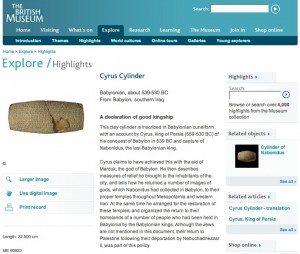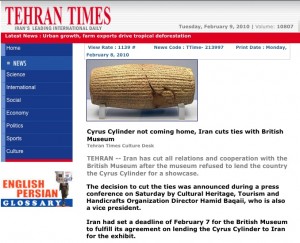This is an overdue and overlong entry, but I have been watching the British Museum-Iran controversy unfold over the past couple of days and wanted to cover it here…
Nowadays, headlines about Iran tend to be about the detention or arrest of opposition leaders, students, and journalists following the contested June 2009 elections. Or the possibility of sanctions for aspects of a nuclear program that more and more seems less and less concerned with simply generating power. Given these issues, the boiling over of an archaeological matter may not seem too important, but the considerable rancor highlights the boundary between archaeology and politics.
 What happened this weekend was that Iran terminated all interaction with the British Museum. At the heart of the bitter accusations from Tehran is what Iran sees as the British Museum reneging on the loan of the Cyrus Cylinder. Found at Babylon (in modern-day Iraq) during an 1879 excavation on behalf of the British Museum, it is inscribed in cuneiform with an account of the conquest of Babylon by the Persian king Cyrus in 539 B.C. Of course, the Persian monarch is described in modest terms: “I am Cyrus, king of the universe, the great king, the powerful king, king of Babylon, king of Sumer and Akkad, king of the four quarters of the world.†But the text is remarkable as a record of the king’s treatment of the peoples (and their religions) who had been uprooted under the dominion of the Babylonians. Here’s the British Museum translation of the critical passage:
What happened this weekend was that Iran terminated all interaction with the British Museum. At the heart of the bitter accusations from Tehran is what Iran sees as the British Museum reneging on the loan of the Cyrus Cylinder. Found at Babylon (in modern-day Iraq) during an 1879 excavation on behalf of the British Museum, it is inscribed in cuneiform with an account of the conquest of Babylon by the Persian king Cyrus in 539 B.C. Of course, the Persian monarch is described in modest terms: “I am Cyrus, king of the universe, the great king, the powerful king, king of Babylon, king of Sumer and Akkad, king of the four quarters of the world.†But the text is remarkable as a record of the king’s treatment of the peoples (and their religions) who had been uprooted under the dominion of the Babylonians. Here’s the British Museum translation of the critical passage:
I sent back to their places to the city of Ashur and Susa, Akkad, the land of Eshnunna, the city of Zamban, the city of Meturnu, Der, as far as the border of the land of Guti–the sanctuaries across the river Tigris–whose shrines had earlier become dilapidated, the gods who lived therein, and made permanent sanctuaries for them. I collected together all of their people and returned them to their settlements….
They aren’t named here, but this is when (and by whom) the Jews were released from the Babylonian captivity.
So, the Cyrus Cylinder is a unique and critical document of human history. Now, let’s go back a bit more than a year ago, to January 19, 2009, that’s when, although UK and Iranian relations were abysmal, Neil MacGregor, director of the British Museum (BM), was in Tehran. John Wilson, reporting for BBC radio, observed optimistically: “An ancient clay cylinder, regarded by scholars as the world’s first declaration of human rights, helps to seal a deal that could open a new diplomatic channel between Britain and Iran.†He describes a meeting with Hamid Baqaie, head of Iran’s Cultural Heritage, Handicrafts and Tourism Organization (ICHHTO), pastries, flags of the two nations, and an agreement. Iran would lend objects for an upcoming BM exhibition about the Iranian emperor Shah Abbas, and the Cyrus Cylinder would go on display for a number of months at the National Museum in Tehran. Iran made the loan and, so far, the British Museum hasn’t. There’s the rub.
Let’s work backward. The latest holdup has been, according to a January BM press release, because two fragments of cuneiform tablets from the small site of Dailem, near Babylon, which have been in the museum’s collection since 1881, have just been identified as having the same text as the Cyrus Cylinder. That’s important for two reasons. First, the fragments just happen to belong to areas where the text on the cylinder is either missing or of obscure meaning. Second, it means the text may have been distributed around the Persian Empire (and hence available to authors of Biblical texts).
The BM maintains that it needs six months to study the two fragments and the cylinder together, and hunt through its collection of cuneiform tablets and fragments to find any additional bits. Congratulations to Wilfred Lambert formerly of the University of Birmingham and Irving Finkel of the Department of Middle East in the British Museum for this discovery. I am sure that Neil MacGregor’s quote that they (the fragments) look like “nothing more than dog biscuits†is unfounded.
So, instead of sending the cylinder and fragments now, the BM proposed “an international workshop at the British Museum in June, to study and assess the new pieces. Scholars from Iran will also be involved in the study and evaluation of the new pieces.†The exhibition in Tehran could begin in July.
Here’s the irony paragraph, an aside that you can skip if you’d like. Who would have thought that Iran’s government would so vehemently demand the loan of an ancient document that guaranteed religious freedom? On the other side, the BM has played a strong role in assessing and protecting Iraq’s cultural heritage in recent years. Good for them. Yet, Wilfred Lambert who is rummaging through their collection (presumably by invitation) has happily authenticated hundreds cuneiform tablets with no provenance or history—surely not looted in Iraq—for London dealers. See our article “Focus on Iraq” or this one from the New York Times in which Lambert says “I don’t necessarily know where it comes from or how long it’s been coming” [the dealers] “don’t themselves, I suspect, very often.”
 Hamid Baqaie of ICHHO, previously seen with pastries and flags, isn’t buying the delay, saying it was unacceptable and politically motivated. That seems unfair, but it’s mild compared to some of the invective and threats. Here’s what the Iranian news agency FARS heard from Baqaie:
Hamid Baqaie of ICHHO, previously seen with pastries and flags, isn’t buying the delay, saying it was unacceptable and politically motivated. That seems unfair, but it’s mild compared to some of the invective and threats. Here’s what the Iranian news agency FARS heard from Baqaie:
Now Iran’s Cultural Heritage, Handicrafts and Tourism Organization makes this official announcement that it will have no relations with the British Museum as of Sunday… Iran will send letters to all world museums to caution them about the consequences of signing agreements with the British Museum before receiving relevant confirmations from the British foreign office as the Museum’s measures are based on political motives.
He was also looking for monetary compensation, saying Iran’s National Museum (overseen by ICHHTO) had spent $200,000 to enhance security systems to protect the no-show cylinder (a claim that unfortunately suggests their own collections aren’t worth protecting much). And forget about any British archaeological work in Iran.
Who is this meant to hurt?
“We are certain that the museum, especially its Middle East department, will suffer a considerable loss from this end of partnership.â€â€”Baqaie, PressTV
“They are thirsty for cultural relations with Iran as a part of the great human civilization. This break in relations will hurt their cultural, research, and scientific complex.†—Baqaie, Tehran Times
Iran and Iranians, too, will lose out. And you and me. Great.
It’s miles over the top, but Iranian frustration stems from multiple delays, following their fulfillment of their side of the bargain. The loan was supposed to begin in September but has been pushed back repeatedly. Baqaie: “The British Museum told us they will transfer it to us in September, then they said November, and then finally said January 16…. Then we got a letter saying they cannot send the cylinder following the Ashura day incidents” [clashes in Tehran between security forces and opposition supporters December 27]. The last chance according to the Iranians was this past weekend. The BM says it confirmed its commitment to the loan in a February 2 phone call and in an email and fax to Baqaie three days later. So, here we are.
Is there a basis for the Iranian complaint? Did the BM make a political decision? You can see the minutes of the British Museum Board of Trustees for September 26 online. Here’s what you’ll find:
The Director reminded the Board that the Museum had made a commitment to loan the Cyrus Cylinder to the National Museum of Iran by the end of 2009. The Chairman sought the views of each Trustee present on the proposed loan in light of recent political developments in Iran. The Board confirmed its commitment to the loan in principle, but asked that the Keeper of Middle East be sent to Iran to carry out a risk assessment and to report back to the Board in November before a final decision was made.
Conspiracy theorists and those looking for the worst interpretation possible will say, yes, there’s the “P†word, right in the board minutes. But ask yourself, if you were the custodian of a unique object like the Cyrus Cylinder, would you have sent it to Tehran then? I wouldn’t. Does identifying Iran’s difficulties as “political†so soon after the elections mean the museum is subservient to the British government and stalling at its behest? Of course not.
The accusations out of Tehran, to a small extent understandable as expressions of frustration, are extreme. Going nuclear here accomplishes exactly nothing. But maybe there’s still time to back up on this. Do the June conference, see if there are more fragments, and share it all with lots of people, in person in London and Tehran and, via the web around the world. Kind of like Cyrus sending copies of his decree around the empire.
Meanwhile, there’s been little movement in the case of Iranian cuneiform tablets at the Oriental Institute and other museums here in the U.S. A federal judge in July 2006 upheld a decision that could lead to the seizure and auctioning off of the collection to compensate victims of a 1997 suicide bombing. We will keep watching that and update our coverage if and when something breaks.
This entry was posted by Mark Rose on
Monday, February 8, 2010.
Discussion of this blog entry is now closed.
Comments posted here do not represent the views or policies of the Archaeological Institute of America.

